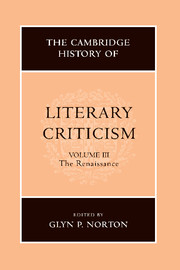Book contents
- Frontmatter
- Introduction
- READING AND INTERPRETATION: AN EMERGING DISCOURSE OF POETICS
- POETICS
- THEORIES OF PROSE FICTION
- CONTEXTS OF CRITICISM: METROPOLITAN CULTURE AND SOCIO-LITERARY ENVIRONMENTS
- 33 Criticism and the metropolis: Tudor-Stuart London
- 34 Criticism in the city: Lyons and Paris
- 35 Culture, imperialism, and humanist criticism in the Italian city-states
- 36 German-speaking centres and institutions
- 37 Courts and patronage
- 38 Rooms of their own: Literary salons in seventeenth-century France
- 39 Renaissance printing and the book trade
- VOICES OF DISSENT
- STRUCTURES OF THOUGHT
- NEOCLASSICAL ISSUES: BEAUTY, JUDGEMENT, PERSUASION, POLEMICS
- A SURVEY OF NATIONAL DEVELOPMENTS
- Bibliography
- Index
- References
39 - Renaissance printing and the book trade
from CONTEXTS OF CRITICISM: METROPOLITAN CULTURE AND SOCIO-LITERARY ENVIRONMENTS
Published online by Cambridge University Press: 28 March 2008
- Frontmatter
- Introduction
- READING AND INTERPRETATION: AN EMERGING DISCOURSE OF POETICS
- POETICS
- THEORIES OF PROSE FICTION
- CONTEXTS OF CRITICISM: METROPOLITAN CULTURE AND SOCIO-LITERARY ENVIRONMENTS
- 33 Criticism and the metropolis: Tudor-Stuart London
- 34 Criticism in the city: Lyons and Paris
- 35 Culture, imperialism, and humanist criticism in the Italian city-states
- 36 German-speaking centres and institutions
- 37 Courts and patronage
- 38 Rooms of their own: Literary salons in seventeenth-century France
- 39 Renaissance printing and the book trade
- VOICES OF DISSENT
- STRUCTURES OF THOUGHT
- NEOCLASSICAL ISSUES: BEAUTY, JUDGEMENT, PERSUASION, POLEMICS
- A SURVEY OF NATIONAL DEVELOPMENTS
- Bibliography
- Index
- References
Summary
No single image, perhaps, better captures the elusive relationship that printing bore to Renaissance literary criticism than the frontispiece of Guillaume Budé's De studio literarum recte ac commode instituendo (1532). Beneath the title, Josse Bade, the renowned Parisian printer of Budé and Erasmus, inserted a woodcut of a printer pulling hard on a press bar, flanked by an inker knocking up the balls on one side, and on the other, two typesetters busy composing. Although it seems to suggest a particular correlation between the best-known Parisian shop of the time and the latest manifesto of France's most celebrated humanist, the image proves to be merely Bade's ordinary device, and a somewhat formulaic one at that. Budé's book in turn registers little awareness of the new medium through which it was destined to pass, and his silence points to the curious fact that while print culture and a new literary consciousness seem to have developed in parallel, they often did so in relative ignorance of each other.
This unwitting indifference could cut both ways. Etienne Pasquier, one of the most perceptive casual critics of contemporary French writers, had little that was perceptive to say about printing except to note with irony that ‘the inventor of artillery was a monk, and of printing a knight’. Notwithstanding the remarkable blind spot that many contemporaries experienced with regard to the ‘print revolution’, modern scholars have been tempted to find in the invention of printing a key to any number of pivotal changes in Renaissance intellectual life.
- Type
- Chapter
- Information
- The Cambridge History of Literary Criticism , pp. 384 - 392Publisher: Cambridge University PressPrint publication year: 1999



